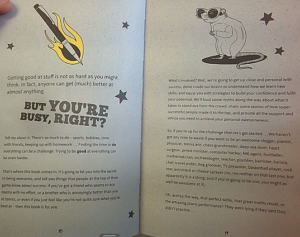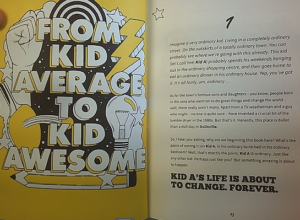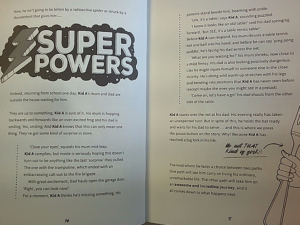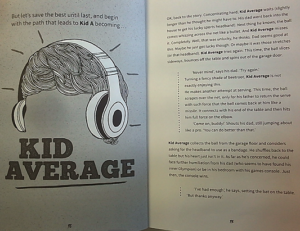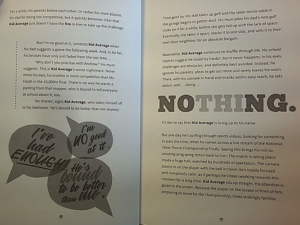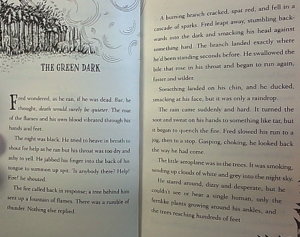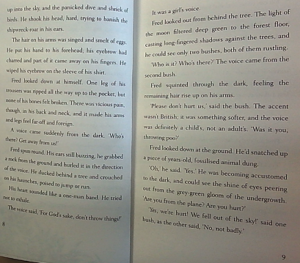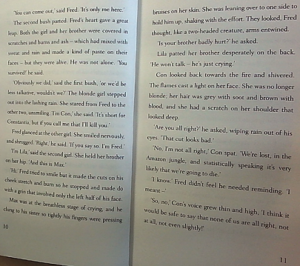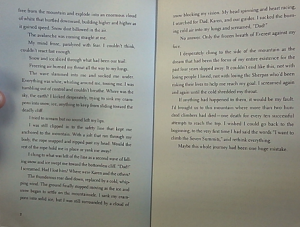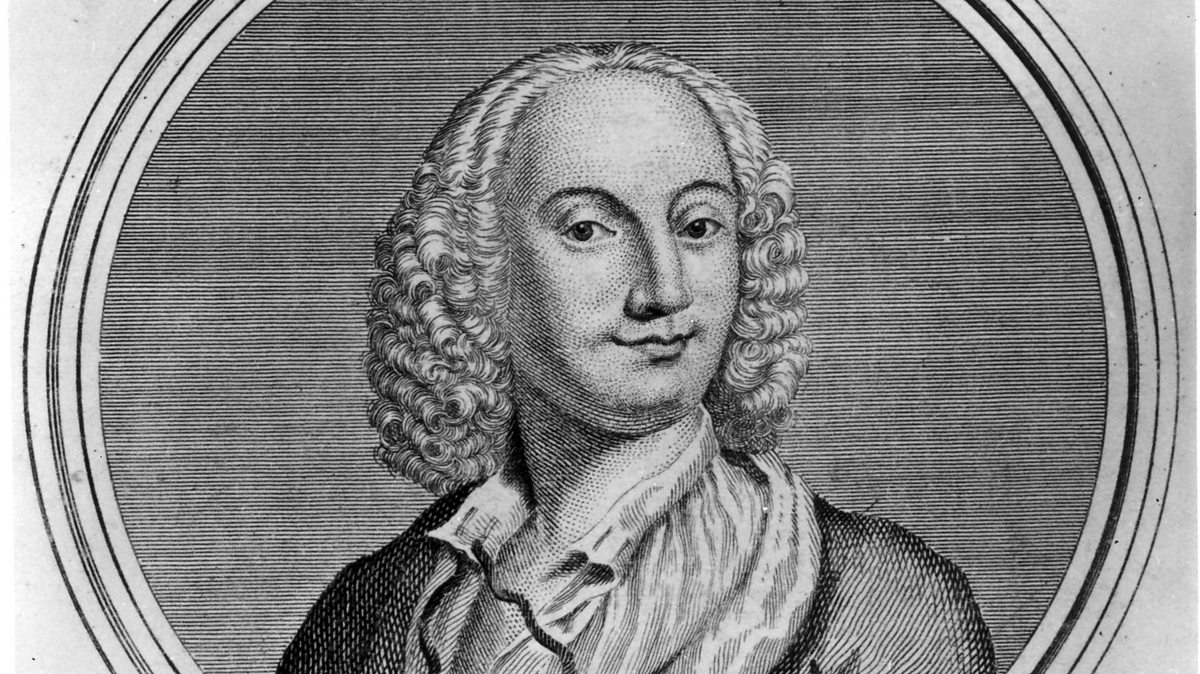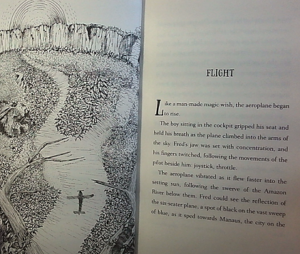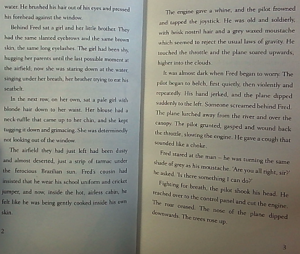Year 6 Home Learning for week beginning Monday 29th June 2020
Hello everybody! Mr Pratley and Mr Land have both been busy getting a ‘Team Year 6’ haircut this week!!! It seems that the hair trimmers are getting used to their scalps but both hairdressers still need to work on their ‘blending’ around the sides and back of the head!!! Both Mr P and Mr L are enjoying the money they are saving from this!!!
This is our English home learning for the week ahead.
For Guided Reading this week, we are returning to ‘The Explorer’ as our text for the week.
Our writing continues to focus on Mount Everest and you will be researching and writing about an animal from the Himalayas!
Guided Reading
Book: The Explorer, by Katherine Rundell
Monday
Write a summary about what has happened in The Explorer so far. Use two paragraphs to summarise the story and start your second paragraph for the summary when you ‘feel’ it is accurate to, to show the shift in what happens in the book thus far. THINK – when is the ‘big change’ in the story so far? At what point does the story change? Which TiP (Time;Place) ToP (Theme; Person) strategy did Rundell use to create the ‘shift’ in the story so far? How do you know? Write and explain this thinking too within your summary…
Tuesday
Read page 12. Respond to the questions below.
- ‘It was speckled brown and black, patchworked to match the jungle floor…’
Look at the extract above.
What makes this a clever and creative bit of writing? Within your answer, identify which words specifically make it creative and engaging – this will justify why it is clever and creative.
2.Look again at the extract in Q1.
It could be argued that there are TWO words that are the key to making the extract in Q1 creative. Which TWO words are they, that combine together to really make the reader visualise the image and relate to how the snake looked on the jungle floor?
3.Look at page 12.
What one word has been used as a synonym for ‘ran?’
4.What made you decide your answer for Q3? Give two reasons why you chose your word.
5.Look at the paragraph beginning, ‘The ground was sodden…’ to the end of page 12 only.
What indicates to the reader that Fred is running fast?
Give three different pieces of evidence from the text.
……………………………………………………
…………………………………………………………………………………..
…………………………………………………………………………..
Wednesday
Read page 13 – 17.
1.Look at page 14.
What took up most of the space in the sky above?
2.Look at page 14.
Fred was tired. Give two pieces of evidence that support this view.
3.Who says, “Now we’re even more lost?”
4.How do you know you are correct for Q3? Justify it.
5.‘There was bite to the question.’
What is the author getting at when they write this as a reflection of HOW Con says his previous speech? What do they mean by it?
6.Look at page 16.
What impression of Lila do you get on this page? Give two pieces of evidence from the text to support your impression.
Impression Evidence
………………………………… ………………………………………………………………………..
………………………………… ………………………………………………………………………..
………………………………………………………………………..
………………………………………………………………………..
7.Look at page 14 – 17.
What impressions of Con do you get from these pages? Give two different impressions and use evidence from the text to support each different impression.
Impression Evidence
…………………………………. …………………………………………………………………………………
…………………………………. …………………………………………………………………………………
…………………………………. …………………………………………………………………………………
………………………………… …………………………………………………………………………………
Thursday
Thinking and reflecting question
Character analysis
Which character do you think will emerge as the hero and main character of the story? What makes you think this? Use evidence from pages 12 – 17 to support your view.
Also, within your answer, write about HOW you think they will go about becoming the hero and the main character within the story…What might happen and change in the story in order for them to emerge as a key character? Write around 120 words in total, developing points and justifying your views.
Friday
Read for enjoyment for 30 minutes.
Writing
Monday – Proofread, edit and improve your writing piece from Friday and check your spellings for silly errors AND for words you are NOT QUITE sure about. For your spellings, re-read your piece of writing from back-to-front, so that you read your last word first, and so on and so on. This way you do not just skim over your words, you look at them even more closely.
THINK – did you include most or all of the points that were made from the video last week? Did you elaborate on your initial point to then show logical thinking and logical reasoning as to why Jordan’s father should or should not have allowed him to scale the mountain? THINK – have you used enough of a range of synonyms for high frequency words or phrases that may appear in your piece, such as the word ‘mountain’ or ‘climb up it…?’ THINK – did you include a range of subordinating conjunctions to open sentences and paragraphs with? These were a part of your spellings list…
Tuesday – RESEARCH about the Himalayan animal that is a ‘yak.’ You can use the Internet to research information about this important and special animal AND/OR you can use the word document that is below. When planning and thinking about your Introduction for your Non-Chronological Report, you could write about why this animal is so important to people climbing Mount Everest and the surrounding landscape of the Himalayas. You should be aiming to find out a whole host of information about this animal as it plays an indispensable role in the successes and outcomes of people seeking to climb Mount Everest.
You should be thinking about what different sections are required to report about – this could range from their diet to what their job role is for climbers to their appearance and what makes their bodies so strong. Think about the effect that these physical qualities bring…
As you are researching, you need to start to PLAN and map out how your Non-Chronological Report will look. You can use a double-page spread within your English writing book so that you have space to write. You can draw a yak on your page too to show the reader the image of it.
Wednesday – FINISH PLANNING and START WRITING your Non-Chronological Report about the yak. I would write the Introduction and one of the sections today and I would ensure that I am writing enough for each section. Your introduction should aim to be around 80 – 100 words and then I would imagine that each different section after that should be at least 80 words per section to ensure some depth and purpose to the report. We don’t want one section being three sentences long!!! Think about the impact that their characteristics and features bring to the world (people) around them. You could maybe group some of their sections together in a sensible fashion…
Thursday and Friday – Continue and finish your Non-Chronological Report. I would be having maybe three other sections on top of the Introduction and ‘Closing’ section. So, it could be around five sections in total.
Spellings
Look; cover; write; check
aching feverishly tongue breathed speckled
somersault unbearable concussion
These are some words from ‘The Explorer.’ See if you can remember any similar words that follow the same spelling pattern. Do this for these words in particular:
Unbearable (-able ending words),
Concussion (-ssion ending words),
Tongue (-gue ending words),
Speckled (-ed ending words).
Make a table or a picture of your groups of words that have the same ending!
Maths
Our maths learning this week will continue to build on our work converting measures from last week. We will find the area of triangles and parallelograms and apply this to solving problems.
Monday
Answer Monday’s arithmetic here
Year 6 Summer week 5 Arithmetic
Click on the link to calculate the area of triangles and parallelgrams
https://classroom.thenational.academy/lessons/to-calculate-the-area-of-parallelograms-and-triangles
If you would like to print out the tasks, they are here:
Tuesday
Tuesday’s arithmetic is here
Year 6 Summer week 5 Arithmetic
The link to the lesson on solving problems with units of area is here:
https://classroom.thenational.academy/lessons/problems-with-units-of-area
The tasks can be printed off here:
Wednesday
Today’s five arithmetic questions are here:
Year 6 Summer week 5 Arithmetic
We are going to learn how to calculate the volume of cubes and cuboids today. Click here for the lesson:
https://classroom.thenational.academy/lessons/volume-of-cubes-and-cuboids
The tasks are here:
Thursday
Your final 5 arithmetic questions are here:
Year 6 Summer week 5 Arithmetic
Our final maths lesson this week is looking at converting between standard units of mass:
https://classroom.thenational.academy/lessons/convert-between-standard-units-of-mass
Here are your tasks:
Friday
Today is all about testing yourself to see how much of your arithmetic skills and knowledge you have retained!
Please complete the attached arithmetic test. Remember to think whether you are best to use a mental method, jottings or written calculation:
WELL DONE!
Geography
This week, we are going to investigate people who may not want to migrate to the cities in Brazil: The indigenous people of the Amazon rainforest.
Work through the presentation pdf. Watch the two video clips and ask yourself:
- What do you think the lives of these people is like?
- How do you think they felt when they saw the plane filming them?
Brazil Lesson 5 Indigenous People of the Rainforest Presentation .ppt
The film footage you watched was of the Awa tribe. The Awa tribe are an uncontacted tribe which live in the Amazon. Brazil is home to the highest number of uncontacted tribes in the world (uncontacted means that the tribes have no contact with the outside, modern world). There are thought to be 77 isolated groups living in the Amazon.
Using the Indigenous people of the rainforest PPT and the Awa Tribe information page (Brazil Lesson 5 Awa Tribe Information Page, collect information about the lives of people in the Awa tribe. You can also read a news report on the tribe here:
www.bbc.co.uk/news/magazine-27500689
TASK
Your task is to use the information you have collected to create a short fact-file on the lives of the people in the Awa tribe. What areas of life will you focus on? What images will you use? How will you introduce your fact-file? Are there any threats to their lifestyle?
Feel free to be as creative as you want in your presentation.
Music
Hans Zimmer
Go to the website below and watch Naomi Wilkinson’s video about Hans Zimmer
https://www.bbc.co.uk/teach/ten-pieces/classical-music-hans-zimmer-earth/zh4k382
|
Hans Zimmer has composed Earth especially for Ten Pieces. The piece is his personal celebration of the planet we live on. With his trademark sense of scale and drama, Hans captures the majesty and …
www.bbc.co.uk
|
Why is Hans Zimmer considered a musical trail blazer?
Now listen to the whole piece in the second video.
Zimmer tells us to,
‘Do what you wanna do with it!’
How can you ‘play and get creative’ with this piece?
Religious education
Our school patronal feast day takes place on Sunday 28th June. In order to prepare for this special time of the year, please choose ONE of the following activities in order to learn more about St. Peter…
- Write a diary entry as St. Peter, when he escaped from prison. Describe how he felt when the Lord sent an angel to free him from the jail that Herod had cruelly locked him up in. How did they get out of the prison?
- Jesus told Peter, ‘I will give you the keys to the Kingdom of Heaven’. Design the keys and include as many symbols as you can to represent St. Peter and why he was so special. What would the keys be made of?
- Jesus said to Peter, ‘You are a rock, and on this rock I will build my church’. Could you paint or decorate a stone or pebble, to show ways in which to build God’s church? (e.g. by spreading love, faith and Good News).
- Create a selection of short prayers to ask for God’s guidance during the global pandemic. How could we demonstrate the courage, faith and commitment that was demonstrated by St. Peter, as we work to support others?
- Take a look at the St. Peter’s logo on our school website. Can you re-design the crest so it reflects the qualities of St. Peter? (e.g. trust, hope, responsibility). Why did Jesus say ‘feed my lambs’? How might St. Peter ask us to continue God’s work on earth?
- Use the internet to research St. Peter – can you make a fact file about our school saint? Which key words might you use as part of your factual information page? Were there any articles about St. Peter that particularly interested or surprised you?
Family Science Activity – Friday 26th June 2020
Giant Bubbles https://www.rigb.org/families/experimental/giant-bubbles – watch the video
· Make a home-bubble mixture and wands. Use them to look more closely at the characteristics and behaviour of soap bubbles.
· ExpeRiment with different shapes and sizes of bubbles and see what you can and cannot control about bubbles. Learn how to make giant bubbles and find out why bubbles are usually round.
· Learn how to make giant bubbles and find out why bubbles are usually round. https://www.rigb.org/docs/giantbubbles_infosheet_0_0.pdf – details on the information sheet.
You will need:
• Good quality washing up liquid
• Water
• Glycerin (optional)
• Plastic tub or other container for bubble mixture
• Measuring jug (optional)
• Various things with holes in them for blowing bubbles with. Watch the video for ideas. Straws, pipe cleaners, paperclips, coat hangers, cookie cutters and cake tins with removable bottoms are all particularly good.
• For giant bubbles: wooden spoons (or other sticks), a couple of metres of string and a small weight you can thread through it, like a metal key ring or nut.
What to do:
A mixture we found that works is 1 litre of water, 100ml of washing up liquid and 30 ml (2 tablespoons) of glycerin. Blow some bubbles!
Put a straw into your bubble solution and try blowing gently into the liquid. You should be able to make a lot of bubbles very quickly. Then dip one end of a straw into the solution, take it out and blow gently through the other end. See if you can control the size of bubble you can blow out of the straw.
Try making bubbles using things with bigger holes, like a paperclip or pipe cleaner bent into a circle. Try poking a dry finger into a bubble, then try the same thing after dipping your finger in bubble solution.
Try making bubbles inside bubbles by poking a straw dipped in bubble solution into an existing bubble and blowing again.
Try out objects with different shaped holes, like cookie cutters or pipe cleaners bent into other shapes. Try objects with really big holes, like a coat hanger or a cake baking tin with its bottom removed. Try making giant bubbles with the special wand we show you how to make in the video.
Going Further:
· You can experiment with your bubble mixture and giant bubble wand to see just how big you can get your bubbles to be. There are lots of different bubble mixture recipes on the internet, just search for “soap bubble recipe”.
· You could try making two or three of them and comparing how good the bubbles they make are.
Art Challenge
Art Challenge: The Great Getaway! TRANSPORT
The title for your art this week is The Great Getaway! TRANSPORT. This can take the form of a drawing, a painting, a sculpture, a collage or anything else that you would like to create. As always, I’m sure you will impress me with your creativity!
Here are some ideas:
Home Learning Week Beginning 22nd June 2020
Hello everybody! Mr P and Mr L have had a good week and enjoyed the sunny evenings going for the odd bike ride and the odd run respectively. They have both been enjoying the Geography work and watching the films based around Rio and learning about the two halves that comprise it.
This is our English home learning for the week ahead. For Guided Reading this week, we are thinking about transition and our mindset when dealing with ‘things’ and tasks that perhaps you have faced within your life. Our writing continues to focus on Mount Everest and Jordan Romero and you will have a writing outcome to complete for it!
Guided Reading
Book: You’re Awesome, by Matthew Syed
Monday
| Adjusting to Change and Managing Change (Our Transition to year 7)
How to maintain our feelings of ‘Feeling In Control’ in our current learning & What this looks like in our life-learning
|
Task
Read page 10 – 15.
Discuss and answer these questions:
1.What options does Kid A face at the end of page 15?
2.How many options does he have?
3.What will he need to do in order to be able to go on this ‘awesome and incredible journey?’
4.What will Kid A need to do if he is to carry on his path of ‘living his ordinary, unremarkable life?’
5.Kid A had table tennis as the situation that presented two options to him.
Have you ever been faced with two options like Kid A had? What was the situation in your life where you were faced with the two options?
6.What did you do when faced with the two options? Which option did you choose?
7.Why did you choose this option?
Tuesday & Wednesday
Discussions and reflections
Read page 16 – 19. Answer these questions:
1) Look at page 17. How could you sum up how Kid A is feeling at this point? How can you tell?
2) Look at page 17. What things happen that make Kid A just not enjoy the table tennis? List all your observations.
3) Is there anyone in particular at fault for why Kid A is not enjoying the table tennis? If so, what makes you think this?
4) Look at page 19. Kid Average views, ‘challenges as obstacles, and definitely best avoided.’
How would you sum up this view that Kid Average has about challenges? How does Kid A view challenges in his life?
5) Have you ever felt like this when you have been faced with certain, specific challenges? What were the challenges that made you feel this way?
6) How did you respond to the challenge that you identify in Q5?
7) How could you have faced the challenge from Q5 in a better, more productive way?
8) What do you think will be your biggest challenge when you move to secondary school in September?
9) Create a set of steps to success that will make your biggest challenge in September more achievable.
10) How are you and Kid A similar? Give examples to hang your ideas on.
11) How are you and Kid A different? Give examples to elaborate on your thoughts.
12) Do you feel sorry for Kid A at all? Why?
13) Does the father’s attitudes and mannerisms change during both table tennis matches?
14) How does the Kid change in his attitudes, mannerisms and outlook between both table tennis matches?
Thursday
Questions – Further thinking and personal reflection
1.Read page 20. How is ‘Kid A Awesome’ different from ‘Kid A Average?’ Sum this up using a phrase from page 20.
2.Kid Awesome doesn’t give up with his table tennis.
Using the continuum line below, mark on the line where you think you are when it comes to ‘not giving up’ with tasks and things in your life.
Tasks and Things in your own life
_____________________________________________________________________
I always give up I never give up
3.Why did you make your mark where you did? List the things you DO or DON’T give up on, to prove your opinion of yourself.
4.How does this make you feel inside? Why?
5.How do you think you could ‘Never give up’ a little more often with things and tasks in your life? Use examples to show HOW you could ‘never give up’ on things and tasks.
6.Would never giving up a little more often be a simple way to live or a hard way to live? Why?
7.‘Anything that is worth having in life takes time and hard work.’ (St Peter’s Year 6 team)
What is this quote getting at? What does it mean? Explain, and use examples from in school or out of school to reveal your thinking.
8.What could you keep devoting time and hard work to, so that you improve gradually over time? List one thing for in school and one thing for out of school.
Friday
Read for enjoyment for 30 minutes.
Writing
Monday – Proofread, edit and improve your short writing piece from Friday. Make sure you check simple spellings and check any silly errors you may have made.
THINK – did you include most or all of the tools and nouns that were mentioned in the brief on Friday? Did you marinade for long enough in the tension of just before the avalanche hit? And, did you immerse in the tension of when it actually did make contact with Jordan and father? Did you write about the bottomless cliff that was situated close by?
Tuesday – Look at the question below.
“Should Jordan’s father have allowed him to climb Mount Everest, given his age?”
You then have to decide ‘Yes’ or ‘No’ to the question OR you can have a balanced viewpoint and therefore make notes about both sides of the question. Personally, I would choose this as I then will have more to write about and I personally can ‘see’ both sides of the argument with this question.
Then, within your notes, justify your reasons ‘why’ in the form of notes, at the moment. I would create a table and I would re-watch the film from last week to refresh my mind and viewpoint. On top of this, I would make notes of the statistics that are mentioned in the film footage and use this as reasons and evidence for your viewpoint.
So, today you are making notes and fleshing these thoughts out.
Remember an introductory paragraph and a closing paragraph and make notes for both of these too. THINK – what would you write about in these? How many people have died? How many have survived? The idea of pushing the human limits and of seeing how far a human can go? The idea of Human Exploration and Evolution? How you cannot control the weather on Everest and the impact of this? How humans should respect the environment and not tamper with ‘Mother Nature?’
Wednesday, Thursday and Friday
Write your developed piece in response to the question above. Take your time…
Remember, you can write a balanced argument if you feel confident when thinking and seeing both points of view during the week. You can then give your own opinion in the closing paragraph about what you ‘truly’ feel if you have chosen a balanced argument form of writing. If you choose to write a balanced argument, remember to use paragraphs to section your thinking.
Think about what subordinating conjunctions you will use to open sentences and paragraphs to either build on a point or when making a new point, eg. On top of this… Furthermore…However…Having said this…Moreover…In stark contrast, it could be argued that…
Spellings, Vocabulary and Grammar
Subordinating conjunctions practise (15 minutes, three times)
Look; cover; write and check these. Think about HOW you could use them in your writing outcome for this week too…
Although… Provided that… Supposing… Rather than… In order to…
Even though… Having said this, Therefore, Furthermore,
On top of this, Moreover, In reality,
Challenge
Look at the spellings words and phrases above.
Which ones are ‘to build upon a point’ and which ones would be used to ‘start a sentence to show the opposite viewpoint of the previous sentence’? Make a table and list the words/phrases under the correct heading. Include the commas that go with the words or phrases too. The ellipsis (…) after the words or phrases within the spellings above show the writer that they need to add other words to these ‘subordinating conjunction openers’ so that these openers then go on to making a subordinate clause.
Going deeper
Create sentences that could work for each word or phrase from the spelling list above.
Maths
In this week’s unit, you will explore measures, including applying your understanding of decimal numbers up to 3 decimal places. You will convert metric measures of length, mass and capacity, then apply this understanding when calculating the area and perimeter of rectilinear figures and the area of parallelograms. Have fun and remember to email in any work that you are proud of.
Monday
You will be getting used to this by now! Please click on the link and complete Monday’s arithmetic questions. There is a little extension question for you if you want a challenge.
Year 6 Summer week 4 Arithmetic
Your independent learning is to generate and describe linear number sequences. Click on the link for the video. The tasks with a little challenge question are below.
https://classroom.thenational.academy/lessons/to-generate-and-describe-linear-number-sequences/
Tuesday
Keep your arithmetic skills alive by completing Tuesday’s arithmetic here:
Year 6 Summer week 4 Arithmetic
Your lesson today is to use, read and write standard units of length, mass and volume. The link will take you to the lesson. Click on the tasks for an extra bit of challenge.
Wednesday
Bit more arithmetic to get you warmed-up. Only five questions plus a little teaser:
Year 6 Summer week 4 Arithmetic
Your lesson today is to convert between standard units of length. Click on the tasks for an extra challenge:
https://classroom.thenational.academy/lessons/to-convert-between-standard-units-of-length
Thursday
Here is today’s arithmetic!
Year 6 Summer week 4 Arithmetic
Your lesson today is to solve problems involving the conversion of length. Click on the tasks for an extra challenge:
https://classroom.thenational.academy/lessons/to-solve-problems-involving-conversion-of-length
Friday tasks
Please log in to Sumdog and MyMaths to complete the tasks set which link to this week’s learning.
History – Windrush Day
Today, Monday 22nd June, is Windrush Day and for this we would like the children to research about what it was and to then carry out the tasks below.
Details of the voyage of the SS Windrush and what it was can be found by typing in this website below OR right-clicking on it and pressing ‘Open Hyperlink.’ Look around the web page and the links available to explore what Windrush was…
Read a poem written by Denniston Stewart who came over on the ship, at http://www.movinghere.org.uk/schools/Britain/windrush.htm OR read it below:
Transcript of Windrush Poem by Denniston Stewart
It was 1948 on the Windrush ship
500 men from the Caribbean was on it
from warm Caribbean sand, to this cold English land.
We spent twenty eight day on the ship and everyone felt
real sick, couldn’t take the tossing of the Windrush
ship. When we heard land ahoy, everyone packed up
their one little grip [suitcase].
The ship docked at Tilbury, everyone began to feel
merry setting foot in the mother country. Looking
round it wasn’t jolly, not what we imagined.
The scene was drab and gloomy with plenty of chimneys
that looked like factories.
And so we stepped on the hallowed British soil, and
looked forward to a future we dreamt would be better
on this our English adventure.
For many the years were rough in fact it was rough and
tough. Everywhere we went what a spectacle, how we
survived God knows it was a miracle, couldn’t find any
place to rest our head a little. For all of us the
future looked uncertain No dogs, No Irish No Blacks,
here in the mother country Britain.
Some started working all the hours God given just to
make a shilling
Many threw pardner*
but life got harder and harder
started suffering racism in every corner
some got charged for murder defending themselves
against the attacker whose weapons were bicycle chains,
winkle picker, knuckle dusters. We still held on and
from the pardner we started to get our life in some
order. We paid a deposit to the banker for our own
little spot and that was that. Things took a while to
get better, through many heart aches we had to suffer
while they kept their stiff upper.
This was just a chapter because after fifty years we
remember the good and the bad, the happy and the sad
of life in the mother country. Equality we never
had, the opportunities we didn’t get,
so now in our children we have our hopes and our
dreams.
We the pioneers have laid a solid foundation in
Britain through blood, sweat and tears, in the heat and
the cold. There’s NO Street Filled with Gold, that was
just a story we were told
the gold is the jewel inside developed through the
suffering fires of time.
So fifty years ago or fifty more to come we remember
the Empire Windrush when she first came.
*Pardner – a West Indian saving scheme
by Denniston Stewart
Thinking and responding
- Look at the transcript above and think about how Denniston felt about Tilbury when the boat docked. Make notes to the side of the poem, like a ‘Read aloud, Think aloud’ in class.
- Think about the treatment many of the passengers received. Jot things down around the poem related to this. This could help you for your future tasks.
- Why do you think some British people behaved like this?
- How could the British people have shown more empathy and understanding to the people that travelled to Britain? Think about the mission statement of St Peter’s too and the six learning circle behaviours that we show in class.
- Read the poem called Hinglan Cole (England’s cold) below by the same poet. Make notes around the poem. What are his overall feelings of England now that he is living here?
Transcript of Hinglan Cole (England’s cold) Oh boy, England is cold!It is so cold!Frost in the morning, snow at midday and black fog atnight time. England is so cold! I left hot Jamaica to die of cold here?Frostbite is killing my fingers and when I walk I slipand tumble in the snow many many times,inside the house it is worse,I have to wrap up with hot water bottles, hat, socks,dressing gown, two sheets and twist and turn all nightlong. In the morning when I lift my head from underthe sheets the amount of smoke that come out my mouthyou would think that I was on fire.In the kitchen four people have one ring each on thestove to cook on. I have to put money in the meter toget a bath and the Indian man who I rent from iswatching me closely. I thank God that they delivermilk to your door, I don’t know how I’m going to copebecause England is cold cold cold. by Denniston Stewart
Task
Imagine you are one of the people who travelled to Britain on the Windrush. Write a letter to your family back home in the West Indies. It could be a letter that has been written by yourself over the course of a few weeks.
The first part of the letter could be you reflecting about how life is on the Empire Windrush ship and you writing about how you are feeling about the prospect ahead and what you hope for and expect once you reach the shores of England…
The next part of your letter could be about describing what Britain is like now you are here, and then comparing this to the West Indies (houses, climate, transport, people) and how the people of Britain are treating you. How do you feel about it – was it what you expected? Why? Use the two poems by Denniston Stewart to help with your thinking for the letter home.
How would you close the letter home? Would you end it in an upbeat way, so that your family at home did not worry too much?
Family Science Activity
Balloon Car Racers https://www.rigb.org/families/experimental/balloon-car-racers – to watch the video
The activity – Make cars which are propelled by balloon power.
Experiment with designs and see what factors affect how fast or how far your car goes.
Learn how a balloon car works just like a rocket.
https://www.rigb.org/docs/ballooncarracers_infosheet_1_1.pdf – to view the information sheet
What to do:
· Make a balloon car based on the instructions Mark gives in the video.
· Decide how you will judge what makes a ‘good’ car – is it how far it goes or how fast it goes?
· Investigate what happens if you have bigger or smaller wheels (you can use other types of lids or make wheels from cardboard and use blu-tac or glue to attach them to the kebab skewers).
· Investigate what happens if you change the design of your car in other ways – you can watch the video again for inspiration for other designs.
Going further challenge:
· Measure how far your car travels using a tape measure.
· Time how fast your car travels ½ a metre – would double the speed be the time that your car would travel 1 metre? Test it out.
· You can find the speed of your car in metres per second using a stopclock and a tape measure: Measure the distance the car travels (in metres) then dividing that distance by the time it took to travel (in seconds).
Art
Art Challenge Feast Days
We have two important Feast Days in our Church calendar for June. The 19th June is the Feast of the Sacred Heart and 29th June is the Feast Day of St Peter and St Paul.
For your art challenge this week I would you to do a creation linked to either of these Feast Days.
The Sacred Heart of Jesus is an object of devotion and always falls 19 days after Pentecost.
As you know, St Peter was given the ‘keys to heaven’ by Jesus and was our first Pope and in Matthew Ch16v18 Jesus said ‘And I tell you, you are Peter, and on this rock I will build my church.’ He is also the Patron St of fishermen. St Paul changed from not believing in Christianity to spreading the word through the letters that he wrote. Naturally, he is the Patron St of writers.
Click on this link for some ideas to inspire you:
Music
Go to the website below and watch Naomi Wilkinson’s video about Grazyna Bacewicz.
https://www.bbc.co.uk/teach/ten-pieces/classical-music-grazyna-bacewicz-overture/zf2k382
|
Grażyna Bacewicz learnt the violin and the piano as a child – and, throughout her life, she enjoyed composing music for both instruments, including piano sonatas and seven violin concertos.
www.bbc.co.uk
|
Why was Grazyna Bacewicz considered a musical trail blazer?
Now listen to the whole piece in the second video. Can you hear the morse code pattern v …- for victory?
Why not try creating your own secretive rhythms
eg. This is top secret.
Don’t tell a soul.
Home Learning Week beginning 15th June 2020
Hello everybody! This is our home learning for the week ahead. It may seem like a lot for Guided Reading and Writing, but it isn’t! It is more about your thinking and applying of this thinking…Stick with it and build your resilience! You’ve got this!
Guided Reading
The Explorer, by Katherine Rundell – Page 6 – 11
Monday
Read pages 6 – 11 and respond to the questions below.
1.Look at the paragraph beginning, ‘The fire called back…’
In the text, what shows the reader that the fire ‘called back’ to Fred?
2.Look at the paragraph beginning, ‘A burning branch cracked…’
What impressions do you get of Fred in this paragraph? Give two impressions. Use evidence to support your answer.
Impression Evidence
1…………………………………………. ………………………………………………………………………………
………………………………………….. ………………………………………..
2…………………………………………. ……………………………………………………………………………….
…………………………………………… …………………………………………
3.Look at page 7.
Why did Fred have to stop running? Give two possible reasons, using inference skills from what the words reveal.
1…………………………………………………………………………………………………………………….
2…………………………………………………………………………………………………………………….
4.Look at page 7 again.
Fred was alone in the forest.
Find two pieces of evidence that support this statement.
Evidence:
1…………………………………………………………………………………………….
2…………………………………………………………………………………………….
5.What kind of state did Fred seem in on page 8?
Use evidence from the text to support your view on how he seemed. Explain the impression you get using the evidence.
Tuesday
Re-read pages 7 – 11 and then respond to the questions below.
6.Look at page 8.
Was Fred happy when he heard another voice in the forest? What gives you this impression? Explain your view.
7.Look at page 9.
At what point does Fred start to ‘soften’ and relax in how he views the voice coming from the bushes? Explain your view. THINK – how do I know?
8.Look at page 10.
What shows that Fred had been physically hurt in the plane crash?
9. ‘Are you alright?’ he asked, wiping rain out of his eyes. ‘That cut looks bad.’
‘No, I’m not all right,’ Con spat. ‘We’re lost in the Amazon jungle, and statistically speaking it’s very likely that we’re going to die.’
‘I know.’ Fred didn’t feel he needed reminding. ‘I meant – ’
Does Con or Fred react worse to the situation they are in? Use evidence from the extract above to support your opinion and EXPLAIN how the evidence SHOWS the person’s reaction and who reacts worse.
10.Look at the dialogue again from Q9.
Which character wanted to try to forget the situation they were in, the most? How can you tell? Use evidence from the text to support your view.
11.Again, look at the dialogue from Q9.
Fred seems the more caring character.
Give three pieces of evidence that show this. Reference the text only.
1……………………………………………………………………
2……………………………………………………………………
3……………………………………………………………………
Wednesday (Language for effect and word meaning)
Read the extract below from page 8 and 9 (the bold words show expanded action phrases and clauses).
Fred spun round. His ears still buzzing, he grabbed a rock from the ground and hurled it in the direction of the voice. He ducked behind a tree and crouched on his haunches, poised to jump or run.
The voice said, “For God’s sake, don’t throw things!”
It was a girl’s voice.
Fred looked out from behind the tree. The light of the moon filtered deep green to the forest floor, casting long-fingered shadows against the trees, and he could see only two bushes, both of them rustling.
(Bold words = expanded action phrases and clauses)
Tasks and questions
1.If you were to re-write this extract above in your own words, which words and phrases seem like pretty regular and normal ones to change and then use in your new, re-written extract? List the words and phrases you feel you could exchange pretty easily.
2.The adults of year 6 feel like they could replace the following words and phrases with other, similar ones from the text above whilst at the same time keeping the overall meaning of the sentence they are in the same:
- spun
- grabbed
- rock
- ground
- hurled
- ducked
- crouched
- looked out
- he could see
- bushes
- rustling
Find words and phrases that mean the same thing for each of the words/phrases above. So, find another word for ‘spun,’ ‘grabbed’ and so on and so on that could fit into their respective sentence.
Thursday and Friday
3.Once you have done Q2 from yesterday, have a go at re-writing the extract shown in Wednesday, using your own new words and your own ideas in order to put your own ‘style’ on the writing piece. Write about 80 – 100 words and include speech in it to show character feelings and/or to move the action on.
Keep up the same levels of action as is shown in Wednesday’s extract above (look at the action parts that are in bold) to keep the suspense up.
Writing (with a reading stimulus cross-over!)
We are going to focus on a writing unit based around Mount Everest as part of a Survival-themed unit. To start with, we are going to look at a book written by Jordan Romero, the youngest person to ever climb Everest and the Seven Summits. In the prologue of his book, ‘No Summit out of Sight’, he starts writing about his experiences whilst making the Everest ascent. He was 13 years old when he climbed the tallest mountain on Earth.
Some of the writing skills and vocabulary you acquired during your Everest and Alex Honnold writing tasks at the start of our Home Learning will be able to be transferred to this writing unit, which will help you all!
Click on the YouTube link below OR Copy and paste this YouTube link below into Google, and then when it comes up, press ‘Skip Ad’ in the bottom right of the video. Then, watch the ABC American News Broadcast (8:36 in length).The news report will give you a good background on Jordan and it will show you real film footage from his ascent of Everest. In the film, from 4:45 to 5:06, this footage of the ice falling is written about in the prologue that he wrote in the book – we are looking at this prologue in our writing for this week, so you really get a ‘sense’ in the film of the seriousness of the situation and the suspense. It is brilliant that we have this video footage then recorded in the format of writing by Jordan himself! https://www.youtube.com/watch?v=RpadzvO5JGM
The pages for the prologue of the book are below. Read the pages too to inform your thinking.
Monday and Tuesday
Tasks and ‘playing around’
1.Look at the extract below from the first paragraph of the prologue (page 1).
‘The weather was perfect, with clear blue sky everywhere I looked. It was a beautiful day for climbing.’
These two sentences create a sense of suspense and tension even though the writer is revealing the positive elements of the surrounding atmosphere. How does the writer create this sense of suspense and tension using these two sentences?
2.Look again at the same extract above.
Why does the writer use such positive language when describing the weather? THINK – what is its purpose?
3.Re-write the extract above from Q1. You can only use two sentences. Change the words of the writing slightly but keep the overall meaning the same.
4.Re-write your two sentences from Q3 now in a different way.
5.Look again at the extract from Q1. Write how it would sound if the opposite were true and the weather was NOT good. You can use more than two sentences if you like. Play around with your idea and try to stretch your language used so the words are not as basic.
Wednesday
Firstly, re-read the short extract from Monday to refresh your mind.
The author, Jordan Romero, then moves on to a new paragraph where he builds the tension even further. Read this new paragraph below.
‘I took one step, then another. Suddenly a thunderous roar ripped through the air. The earth rumbled and shifted beneath my feet.’
6.Which sentence from the extract above creates the most tension? Why is this?
7.What is it that makes the other two sentences LESS suspenseful? Use evidence from the two sentences to support your opinion.
8.The extract above is written with the idea of the ‘Power of Three’ to really drill home the idea of suspense in the writing – three sentences in a row to build the tension, one after the other. Does he do a good job? If so, how does he? If he does not, what are the sentences lacking?
9.Now, you have a go at re-writing the three sentences in bold from above. Change the words slightly but keep the overall meaning and IMPACT the same.
10.Now, have a go at writing what you think the next three sentences should be that follow the three sentences above. For these next three sentences, keep the tension high! THINK – how could you keep building this tension? What else could you be looking at or thinking about? THINK about your senses if in doubt…Just because they are tension-filled, it does not mean you have to ONLY have short sentences. Tension can be built with longer sentences too, as long as you get in some specific description and really consider what it is you are observing.
11.‘I took one step, then another. Suddenly a thunderous roar ripped through the air. The earth rumbled and shifted beneath my feet.’
Romero’s next three sentences in the prologue that follow the three sentences above in (11), read as follows:
‘I looked up and saw a ten-story wall of ice and snow break free from the mountain and explode into an enormous cloud of white that hurtled downward, building higher and higher as it gained speed. Snow dust billowed in the air.
The avalanche was coming straight at me.’
Does he keep the suspense and tension up within these three new sentences above? How does he? Use words and phrases from the text to support your view.
12.Is the first, long sentence starting, ‘I looked up…’ effective in building tension and suspense? Why is it? How does it build the tension? THINK about word power!
13.Is there a good balance of short and long sentences if you put both extracts from Q11 together, like it is in the book?
14.Why does Romero use a new paragraph for, ‘The avalanche was coming straight at me’?
THINK – which TiP ToP (Time/Place/Theme/Person) strategy does he use in order to know and realise that he needs to start a new paragraph?
Thursday and Friday
Expanding our ideas
15.After Jordan saw the avalanche coming straight for him, he writes about what he experienced when the avalanche came down the mountain towards him. He writes for about 100 words, talking about his senses and how the snow and ice affected him. He also writes about the equipment he had and what happened during this time and how some of his gear saved him. He writes about what he did with his crampons and the rope he once held on to, and about being attached to the safety line. His voice was also a tool he used to save himself. He also talks about the bottomless cliff that lay not too far away from where he was.
Use the ideas above and the nouns underlined to create the next part of the story from the point of, ‘The avalanche was coming straight at me.’ Try to make it around 100 words (ten lines) and DO NOT move on further than when he finds his father. Marinade in the tension of being in the avalanche and the worry of getting pulled closer to the bottomless cliff, until the avalanche stops…
Spellings (Every day this week for 15 minutes)
Look; cover; write; check the following spellings from Romero’s prologue
Traversed vertical beautiful thunderous enormous hurtled
Billowed avalanche desperately anchored crampons vision
Existence bottomless cliff
Challenge
Find the meaning of the following words: traversed, hurtled, billowed, avalanche, anchored, crampons.
Now, find synonyms for the following words: traversed, thunderous, enormous, hurtled, billowed, avalanche, anchored, bottomless cliff.
Going deeper
Use the 14 spellings above within a short piece of writing. See if you can use all the words…Use the words as your inspiration and ideas for writing…!!! I would use the prologue as a stimulus for your writing BUT I would make it my own!!!
Maths
Our maths learning this week will continue to revise and develop our understanding of fractions, this time focusing on multiplication and division. We will continue to use the Oak Academy Lessons supplemented with some additional questions.
Pupils should also be keeping their recall of times tables facts sharp by aiming to practise these on TT Rockstars for 10 minutes, 3 times per week.
Monday
Please complete Monday’s arithmetic questions (and the extension task if you would like further challenge)
Year 6 Summer week 3 Arithmetic
Now work through the lesson on representing multiplication with proper fractions:
A worksheet with the lesson problems plus a few more challenging questions can be found here:
Tuesday
Please complete Tuesday’s arithmetic questions (and the extension task if you would like further challenge)
Year 6 Summer week 3 Arithmetic
Now complete the lesson: To multiply pairs of proper fractions
https://classroom.thenational.academy/lessons/fractions-to-multiply-pairs-of-proper-fractions
The worksheet problems with a bit more challenge can be found here:
Wednesday
Please complete Wednesday’s arithmetic questions (and the extension task if you would like further challenge)
Year 6 Summer week 3 Arithmetic
Now complete the lesson: To divide a proper fraction by an integer
https://classroom.thenational.academy/lessons/fractions-to-divide-a-proper-fraction-by-an-integer
The worksheet’s here:
Thursday
Please complete Thursday’s arithmetic questions (and the extension task if you would like further challenge)
Year 6 Summer week 3 Arithmetic
Today we are going to apply what we have revised/learnt this week to solve some problems:
Here are today’s questions:
Friday
Yay it is Friday again! Please spend a bit of your time visiting MyMaths, Sumdog and TTRockstars to complete the tasks that have been set which link in with this week’s maths learning 🙂
GEOGRAPHY – Brazil Study
This week’s lesson is titled – ‘A City of Two Halves’.
Starter – here is a part of a picture of Rio De Janeiro. Quickly sketch what you think can be seen in the missing half.
Brazil Lesson 4 Incomplete Rio Image
I wonder what you came up with? Now open the pdf slide presentation below and read through the first three slides to find the complete photograph. What do you think has happened to create this situation?
Brazil Lesson 4 A City of Two Halves Presentation
Now move on to watch the video and make some notes about life in the favela of Rochina. You can click on the link in the pdf, or the one here:
https://www.bbc.co.uk/bitesize/clips/zgp4d2p
You now need to complete a Venn diagram identifying the similarities and differences between life in the Rochinha favela and Barra Di Tijuca. The following notes will help:
Brazil Lesson 4 Barra Di Tijuca Information Page
Brazil Lesson 4 Venn Diagram Template
Great! You should now have a better understanding of what it is like for a child who lives in the poorer half of a Brazilian city. Use this to choose from one of the following tasks:
1.What do you think a child living in Rochinha or in Barra di Tijuca might want for their birthdays? Write a developed paragraph explaining your reasoning behind your choices.
OR
1.Imagine you live in Rochinha or Barra di Tijuca. Write a diary entry describing a typical day in your life.
Religious education
Following the celebration of Pentecost in our Church calendar, we would like you continue to reflect upon our Mission and how we can ‘use the gifts God gave us to make our world a better place’.
Just as the Holy Spirit had appeared to the Apostles of Jesus and gave them hope while they were in Jerusalem, we would like you to consider how YOU can use the power of the Holy Spirit to support and encourage others.
Can you complete ONE of the following activities, to explore how we can continue God’s work on Earth as His followers?
– Design a logo for a charity that you feel could be made in order to support others. You can be as creative as you like! Can you include symbols of the Holy Spirit?
– Research one of the following organisations: CAFOD, Christian Aid, Missio. What is special about this charity? How do they put the needs of others first?
– Create a new school Mission Statement for St. Peters – what else can we do to help others in our community and the wider world? Which actions do you feel would be most important?
– Paint a picture of Oscar Romero. How did he follow the values set out by our school Mission Statement? Can you include key facts about his work?
– Write a letter to your local priest. Could you suggest any ways in which you could support the Church in raising money for good causes, in the future? E.g. by helping in a bake sale or coffee morning, once it is safe to do so.
ART
This week’s KS2 art challenge can be found here:
PDF link: Art Challenge KS2
MUSIC
Antonio Vivaldi
Go to the website below and watch Stephanie Childress’ video about Antonio Vivaldi.
|
Classroom resources for Ten Pieces Trailblazer Antonio Vivaldi, one of the first people to compose music that was designed to remind listeners of places and things in the world around them.
www.bbc.co.uk
|
Why was Antonio considered a musical trailblazer?
Now close your eyes and listen to the whole piece on the 2nd video.
What pictures come into your head?
Find a creative way to respond to the music. This could be by dancing, drawing, painting or writing a poem. You may have your own idea.
Challenge
Why not listen to another piece from Vivaldi’s Four Seasons- Spring, Autumn or Summer?
FAMILY SCIENCE
Candle chemistry
**Please note that this activity must be carried out in the presence of an adult to ensure safety**
Safety advice for parents
· Do the activity on a table which is cleared of any other flammable objects or materials. Use your judgement as a parent to decide whether or not to let your child light the candles on their own.
· Make sure you’ve blown out any candles after doing the activity. Don’t move a lit candle when doing this activity. Don’t allow your child to touch the wick or candle until it has completely cooled.
· Don’t leave a lit candle unattended at any time. There’s more extensive safety advice on using candles from the UK Fire Service here: http://bit.ly/BeFireSafe
The activity
· Make a blown out candle relight as if by magic.
· ExpeRiment to find out how long a candle will burn in different amounts of air.
· Learn about the chemistry of how a candle burns. https://www.rigb.org/families/experimental/candle-chemistry
What you will need
· At least one tea light or other small candle.
· Gas-powered cooker lighter (or long handled matches).
· Glass jars or glasses of various sizes.
· Stopwatch (maybe the one on your smartphone) or other way of measuring time.
What to do https://www.rigb.org/docs/candlechemistry_infosheet_0_1.pdf – for information sheet about the activity.
Going Further Challenge: Learn more facts about fire: http://bit.ly/FireFacts Make a carbon dioxide fire extinguisher for your candles: http://bit.ly/CO2Ext Watch a video on how candles are made: http://bit.ly/CandlesMade Use a candle to suck water into a glass like Josh does at the end of the film: http://bit.ly/WaterCandle
Home Learning Week Beginning 8th June
Good afternoon everyone! We hope that you are well and safe. Mr Pratley has been busy this week trying to emulate the great Mary Berry by making a cake for Mrs Pratley as it is an important birthday for her! We are sure it will taste great! And, Mr Land has had a much more low-key week compared to Mr P…He has been resting a calf strain and taking it easy!
For those children attending St Peter’s this week, another reminder that Monday and Thursday are our PE days so please wear your kit into school on those days.
Here is the Home Learning for the week ahead…
Guided Reading (30 mins per day) Year book for the Summer: The Explorer, by Katherine Rundell
Monday – look at the front cover of our new book study, The Explorer.
Task – Using the image above and what is within it, explain what you think the book will be about. Justify the reasons for your thoughts. Make multiple points for your thoughts and explain each point. Make this a good, developed paragraph. THINK – what can you see? What is around the outside of the cover? What nouns can you see within the image? THINK – how might these nouns impact upon the story?
Tuesday – read pages 1-4 below, from The Explorer. Then, answer the questions.
| Retrieval questions and finding evidence to prove it
1) What has happened on page 1? 2) Was Fred the pilot or the passenger? How do you know? 3) Look at page 1. Was the Amazon River running in a straight line or did the river have bends to it? 4) Find one word on page 1 that shows your answer to (3)? 5) Was Fred sat in an aisle seat or a window seat? 6) What evidence from the text on page shows your answer to (5)?
|
Wednesday – Look at Chapter 1 again and answer the questions below.
LO: to identify word meaning through text understanding and the ‘GIST’
- 1)Look at page 1-3.
What words, phrases and clauses show that the setting of the book is set in the Amazon? Next to your evidence, state whether each piece of evidence is a word, phrase or clause. (3)
- 2)Look at page 1.
What words and phrases show that there is an ‘air’ and ‘sense’ of tension and nervousness? Explain why each word you have chosen shows a ‘sense’ of nervousness and possible tension. (4)
- 3)What phrase is used to describe the river water below? (1)
- 4)Look at page 2. What phrase shows the climate of the area? (1)
- 5)‘The trees rose up.’
What does this sentence indicate to the reader? What is it actually telling the reader? (1)
- 6)Why is the sentence in (Q5) a clever and subtle sentence? (1)
Thursday – Have a go at these trickier THINKING questions.
GOING DEEPER – Analysis of author language choice and their CONSCIOUS CONTROL OF SENTENCE LENGTH for impact
1)Look at chapter 1 again.
- Read from the paragraph beginning, ‘Fred stared at the man…’ to the end of the chapter.
How does Rundell use suspense to build tension? Reference phrases OR clauses OR sentences that show where the suspense builds tension and then justify your answer. (4)
- 2)Again, read from the paragraph beginning, ‘Fred stared at the man…’ to the end of the chapter.
How does Rundell use dialogue to show character feelings? Reference phrases OR clauses OR sentences of speech that show where the dialogue shows character feelings and then justify your answer. (4)
Friday – Read for enjoyment for 30 minutes.
Writing (50 minutes per day)
Monday – Think about what you did on the weekend that was exciting and maybe a little adventurous.
Task – Practise writing a range of short sentences for impact and precision that reveal WHAT was exciting/adventurous about your event and how this happened. Imagine you are in the role of writing a story, so you could use first person (I) or third person (he, she).
Further task – Now, write a variety of longer sentences that perhaps describe what you could see, hear, feel (think of your senses) when you were out on the weekend, JUST BEFORE the moment you broke into the exciting or adventurous situation you found yourself in.
Tuesday, Wednesday & first part of Thursday (20 minutes)
The Explorer, by Katherine Rundell – Chapter 1 writing opportunity
-Read chapter 1 again.
-Then, go towards the end of the chapter.
-Read again from, ‘Fred stared at the man…’ to the end of the chapter.
Task – Your task is to re-write this scene. Imitate, vary and improve how Rundell uses short sentences for suspense, and dialogue to show character feelings, when you are re-writing and maybe adding to the scene.
So, you have to create your own ending to the chapter. You could use the spellings for this week for some ideas within your writing too.
-The end of the chapter has to be between one and two pages long, but no more than 2 pages. THINK about your CONSCIOUS (DELIBERATE) USE OF LANGUAGE AND SENTENCES USED FOR A PURPOSE AND REASON – ask yourself as you are writing, ‘Why have I included this sentence? What is its function/job/purpose? How does it add ‘value’ to the writing?’
-Make sure you have a good grasp of what has happened in the chapter up to the paragraph beginning, ‘Fred stared at the man…’ so you can then write a believable and realistic piece that would be able to take the place of what is there already.
The rest of Thursday (30 minutes) & Friday
Look at what you have written so far for your end of chapter 1 story. On the next new page from where you are at, respond to these REFLECTIVE questions relating to your end of chapter story writing.
- 1)Does it flow and link together well? How can you tell? Prove it and justify your thinking.
- 2)Why have you used new paragraphs in your writing?
- 3)For each new paragraph, which TiP ToP (Time; Place; Topic; Person) idea did you decide to use to then be able to start a new paragraph?
- 4)Did you use similar ideas to Rundell for the end of the chapter or different ideas?
- 5)Which of your ideas were similar and which were different? Prove your thinking using evidence from your writing and Rundell’s writing to show how they are similar or different.
- 6)Which is your most powerful short, suspenseful sentence?
- 7)Why did you choose this sentence for (Q6) as being the most powerful? THINK – what do the words get across to the reader?
- 8)Which is your weakest sentence in the end of your chapter?
- 9)Why did you choose this sentence as your weakest one? What makes it weaker than the other sentences? THINK about a couple of reasons…
Spellings – 3 x a week for 15 mins each time:
Look; cover; write; check (and any strategies you know work well for you).
aeroplane concentration twitched grimacing ferocious whine lurched ceased
Further thinking to help with your English tasks for the week:
Think about what each of these 8 words mean and then think about any synonyms you know for them off the top of your head. eg. concentration = focus…
Now, look up each word and find synonyms that are similar in meaning to each word. THINK – what is another word for ‘aeroplane?’ And another? And another?
Think of ways that you could hook in some of these spellings to your end-of-chapter story. Some of these spellings could really give you ideas to write about. For example, ‘aeroplane’ will immediately give you the subject of a sentence…’Twitched’ could give you the reaction of a character or the aeroplane itself…Maybe the plane ‘twitched’ in its movement as a propeller ‘ceased’ working…
Enjoy!
MATHS
This week in maths we are going to revise and deepen our understanding of fractions in a range of contexts. We have also introduced a daily arithmetic task to keep your skills sharp! If you are unsure of how to solve any of these calculations, visit the resources on Satsbootcamp.co.uk for a refresher.
Monday – To recall and use equivalence between fractions and decimals.
Arithmetic warm-up – click on the link to complete Monday’s 5 questions
Year 6 Summer Week 2 Arithmetic
Now work through the Oak National Academy lesson here:
https://www.thenational.academy/year-6/maths/decimal-and-fraction-equivalence-year-6-wk2-1#slide-1
The worksheet questions plus a couple of additional problems are here:
Tuesday – To find decimal equivalents of fractions.
Arithmetic warm-up – click on the link to complete Tuesday’s 5 questions
Year 6 Summer Week 2 Arithmetic
Now work through the Oak National Academy lesson here:
https://www.thenational.academy/year-6/maths/decimal-equivalents-of-fractions-year-6-wk2-2#slide-4
The worksheet questions plus a couple more can be found here:
Wednesday – To add fractions with different denominators
Arithmetic warm-up. Click on the link and complete Wednesday’s questions.
Year 6 Summer Week 2 Arithmetic
Now take part in the lesson here. When you come to do the independent tasks, click on the Wednesday task link.
https://www.thenational.academy/year-6/maths/add-fractions-year-6-wk2-3#slide-1
The independent tasks can be printed off here:
Thursday/Friday – To apply our skills in a real-life problem.
The South Shore Running Club Problem – click on the link below to read about this problem, then complete the 3 related tasks.
Thurs Fri running club pupil tasks
Remember to email in any completed work that you are proud of!
Geography – Urbanisation: The Great Tug of War.
In this week’s lesson, we will learn about what pushes Brazilian people to want to leave the rural area of Caatinga and why they are pulled towards urban centres such as Brasilia. Your task is to write a letter in role as a resident of Caatinga, explaining to a friend what is pushing and pulling you to move into the city.
First – read the pdf powerpoint slides
Watch this video to learn more about push and pull factors:
https://www.bbc.co.uk/bitesize/guides/z8x6wxs/video
There are some more images of rural and urban Brazil here:
Brazil Lesson 3 Images of Brazil
Your task:
Imagine that you live in The Caatinga. Write a letter to your friend explaining why you want to move away from your village (push factor) and move to Brasilia (pull factor).
You can use the writing frame here to help you:
Family Science Activity – Friday 5th June 2020
Homemade Lava Lamp https://www.rigb.org/families/experimental/homemade-lava-lamp
ExpeRiment with objects of different shapes and sizes. See what makes a difference to whether something sinks or floats in water.
Learn how an object’s density affects if something is likely to sink or float. https://www.rigb.org/docs/lavalamp_infosheet_0_1.pdf
Questions to ask children:
· Before each activity: can you predict what will happen? Why do you predict that? (For example, can you predict what will happen when we squash the tin foil really tightly?
· Can you predict what will happen if we use metal spoon instead of a plastic one?
· Can you predict what will happen if we peel the fruit?) Why does the diet drink float while the non-diet one sinks?
· What do you think will happen when we pour the oil into the glass of water? Why?
· What do you think is in the bubbles that are rising up in the lava lamp? Why do you think they sink back down again?
Going Further:
· You can give your child or children a lump of plasticine and explore how to mould the plasticine into shapes that float. Discuss what the floating shapes have in common compared to shapes that sink.
· The density of an object affects its buoyancy. You can learn more about this and how density affects whether something sinks or floats here: http://bit.ly/
· Buoyancy You can try to make a ‘density tower’ by floating liquids of different density on top of each other, as shown in this video: http://bit.ly/DensityTower · Here’s a quick lava lamp using fizzy water – http://bit.ly/FizzyLavaLamp
ART Challenge
Read all about it! St Peter’s are IN THE NEWS!
For this week’s Art Challenge I would like you to produce some art using old newspapers or magazines! It can be anything from cutting out shapes and creating your own abstract art, or landscape, to making something using Paper Mache. What you make can be left black and white or even painted (using watercolours is very effective). Whatever you create I’m sure you will ‘Make the headlines’ on the Art Blog!
Click on the link for some inspiring ideas!
Art challenge Read all about it
However, if this doesn’t appeal to you can still send any other art work to me and I will post that on the Blog too.
Please email your artwork to me:
n.pearson@stpeterswaterlooville.hants.sch.uk
Thank you
Keep creating and keep safe!
Mrs Pearson
MUSIC HOME LEARNING:
Go to the website below and watch Naomi Wilkinson’s video about Heitor Villa Lobos.
https://www.bbc.co.uk/teach/ten-pieces/classical-music-heitor-villa-lobos/z4nsmfr
Why was Heitor Villa Lobos considered a musical trailblazer?
Now listen to the whole piece on the 2nd video.
Choose your own form of transport. What is the main rhythm it makes? (For example what rhythm might the pedals on a bike or the oars on a rowing boat make?)
How could you play this rhythm? (Perhaps you could recreate the rhythm of the oars by splashing your hand in a bowl of water.)
What other sounds does your transport make? How can you add these? Could other members of your family join in so you can layer the sounds?

